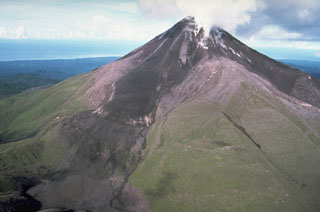Report on Bagana (Papua New Guinea) — October 1986
Scientific Event Alert Network Bulletin, vol. 11, no. 10 (October 1986)
Managing Editor: Lindsay McClelland.
Bagana (Papua New Guinea) Continued lava extrusion; vapor emissions
Please cite this report as:
Global Volcanism Program, 1986. Report on Bagana (Papua New Guinea) (McClelland, L., ed.). Scientific Event Alert Network Bulletin, 11:10. Smithsonian Institution. https://doi.org/10.5479/si.GVP.SEAN198610-255020
Bagana
Papua New Guinea
6.137°S, 155.196°E; summit elev. 1855 m
All times are local (unless otherwise noted)
"Seismicity and visual surveys indicated that the viscous extrusive phase from Bagana's summit crater continued into October at a moderate level. [White to brown emissions] were quietly released from the crater, with a weak glow at night. Daily reports of glow on the northern flank of the volcano from 21 to 29 October suggested that new lava was flowing into the active channel. Seismicity remained at 0-25 B-type events/day, the lowest rate since January."
Geological Summary. Bagana volcano, in a remote portion of central Bougainville Island, is frequently active. This massive symmetrical cone was largely constructed by an accumulation of viscous andesitic lava flows. The entire edifice could have been constructed in about 300 years at its present rate of lava production. Eruptive activity is characterized by non-explosive effusion of viscous lava that maintains a small lava dome in the summit crater, although occasional explosive activity produces pyroclastic flows. Lava flows with tongue-shaped lobes up to 50 m thick and prominent levees descend the flanks on all sides.
Information Contacts: P. Lowenstein and P. de Saint-Ours, RVO.

